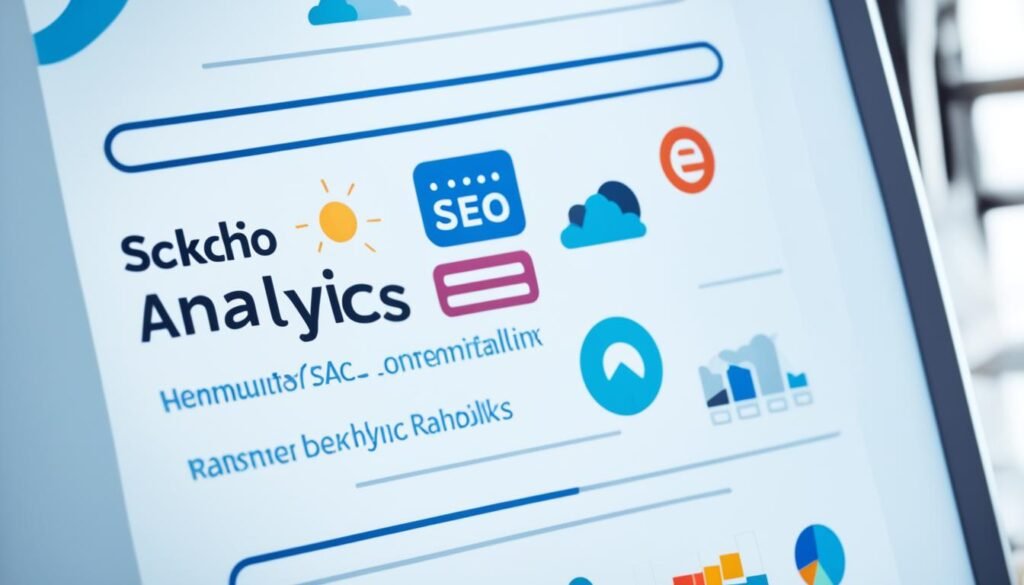Digital marketing has become an indispensable tool for businesses looking to drive sales growth and increase revenue. By harnessing the power of digital channels and optimizing campaigns, businesses can generate leads, improve conversions, and achieve long-term growth. In this article, we will explore key strategies to effectively utilize digital marketing for sales growth.
Whether you are a small startup or a large corporation, digital marketing offers you the opportunity to reach and engage with your target audience in a way that traditional marketing methods often fall short. By implementing the right tactics and considering additional strategies, you can maximize your digital marketing efforts and achieve significant sales growth.
So, how can you utilize digital marketing for sales growth? Let’s dive into the key considerations and strategies that will help you optimize your campaigns and drive revenue.
Key Takeaways: Digital Marketing For Sales
- Define clear goals and metrics for your digital marketing campaigns.
- Understand your target audience and competitors to create effective campaigns.
- Choose the right channels and tactics based on your goals and ROI.
- Monitor and optimize your results using data-driven analysis and experimentation.
- Consider additional strategies such as personalized customer engagement and engaging content.
Define Your Goals and Metrics
Before embarking on a successful digital marketing campaign, it is crucial to define clear goals and establish metrics to measure success. Each goal serves as a foundation for your campaign strategy and a benchmark for evaluating its effectiveness.
Identifying Your Objectives
- Brand Awareness: If your aim is to increase brand awareness, focus on enhancing your online presence, attracting a wider audience, and increasing visibility in search engine results.
- Traffic Generation: To drive more traffic to your website, focus on optimizing your digital marketing efforts to attract visitors and encourage them to explore your products or services.
- Email List Growth: Growing your email list can be a valuable strategy for nurturing leads. Concentrate on capturing email addresses, providing valuable content, and engaging with subscribers.
- Sales Boost: If the primary objective is to increase sales, craft a strategy that focuses on generating leads, nurturing potential customers, and optimizing the conversion process.
Key Performance Indicators (KPIs)
Once you have defined your goals, it is crucial to identify the key performance indicators (KPIs) that align with each objective. These metrics will help you track and measure the success of your digital marketing campaign.
Some essential KPIs include:
| KPIs | Definition |
|---|---|
| Impressions | The number of times your ad or content is shown to users |
| Clicks | The number of times users click on your ad or content |
| Conversions | The number of users completing a desired action, such as making a purchase or filling out a form |
| Return on Investment (ROI) | The ratio of profits gained to the investment made in your digital marketing campaign |
By continuously tracking and analyzing these metrics, you gain valuable insights into the performance of your campaign and can make data-driven decisions to optimize your digital marketing efforts.
Know Your Audience and Competitors

Understanding your target audience and competitors is crucial in digital marketing. By gathering data on audience demographics, behavior, and feedback, you can create strategies that resonate with your target audience and drive engagement. Utilize tools like Google Analytics and Facebook Insights to gain insights into your audience’s preferences, interests, and online behavior.
Collecting data through surveys is also a valuable technique to gather feedback directly from your target audience. Surveys allow you to understand their needs, preferences, and pain points, providing valuable information for crafting effective digital marketing campaigns.
“Knowing your audience is the key to creating content that connects and converts.” -John Smith, Digital Marketing Expert
Researching your competitors is equally important. Analyze their strategies, keywords, and content to identify opportunities and gain a competitive advantage. Tools like SEMrush, Moz, and BuzzSumo provide insights into competitor keywords, content performance, and overall marketing strategies. By understanding what works for your competitors, you can refine your own campaigns and stay ahead of the curve.
Remember to continuously monitor and analyze data from Google Analytics, Facebook Insights, and other tools to refine your targeting, content, and strategies. By staying up-to-date on your audience’s behavior and preferences, you can optimize your digital marketing efforts for maximum impact and achieve better results.
Key Strategies:
- Utilize Google Analytics and Facebook Insights to collect data on audience demographics, behavior, and feedback.
- Conduct surveys to gather direct feedback from your target audience.
- Research your competitors using tools like SEMrush, Moz, and BuzzSumo to gain insights into their keywords, content, and overall strategies.
- Continuously monitor and analyze data to refine your targeting, content, and strategies.
| Tool | Features |
|---|---|
| Google Analytics | – Audience demographics and behavior – Conversion tracking – Website performance metrics |
| Facebook Insights | – Audience engagement metrics – Post performance analysis – Page reach and impressions |
| SEMrush | – Competitor keywords – Backlink analysis – Content performance insights |
| Moz | – SEO analysis – Keyword research – Website metrics monitoring |
| BuzzSumo | – Content analysis and discovery – Influencer identification – Topic research |
By leveraging these strategies and tools, you can gain valuable insights into your target audience and competitors, enabling you to create targeted and engaging digital marketing campaigns that drive results.
Choose the Right Channels and Tactics

When it comes to digital marketing, there is no shortage of channels and tactics to choose from. To ensure the success of your campaigns, it’s crucial to select the right ones that align with your goals and target audience.
Search Engine Optimization (SEO)
One of the key tactics for driving organic traffic to your website is search engine optimization (SEO). By optimizing your website with relevant keywords and user intent in mind, along with paying attention to technical factors, you can improve your organic search rankings and attract more visitors.
Pay-Per-Click Advertising (PPC)
Running pay-per-click (PPC) advertising campaigns is another effective way to reach your audience. Platforms like Google Ads and Facebook Ads allow you to target specific keywords and demographics to increase visibility and drive targeted traffic to your website.
Content Marketing
Engaging your audience through valuable and informative content is a powerful tactic for digital marketing. By creating content that addresses their pain points and provides solutions, you can build trust and establish yourself as an authority in your industry.
Email Marketing
Email marketing is a cost-effective tactic for nurturing leads and encouraging conversions. Through personalized emails, you can deliver targeted messages to your audience, providing them with relevant content and offers that align with their interests and needs.
Social Media Marketing
Social media platforms offer a vast audience for your digital marketing efforts. By building a strong social media presence and engaging with your followers, you can increase brand awareness, drive traffic to your website, and foster meaningful connections with your target audience.
Conversion Rate Optimization (CRO)
Conversion rate optimization (CRO) is the process of improving the percentage of visitors who take desired actions on your website, such as making a purchase or filling out a form. By analyzing data and conducting experiments, you can identify areas for improvement and optimize your website for better conversion rates.
Choosing the right digital marketing channels and tactics based on your goals, target audience, and ROI is essential for driving results. A well-rounded strategy that incorporates SEO, PPC advertising, content marketing, email marketing, social media marketing, and CRO can help you reach and engage your audience effectively.
| Channels | Tactics |
|---|---|
| Search Engine Optimization (SEO) | Optimize website for organic traffic |
| Pay-Per-Click Advertising (PPC) | Run targeted ad campaigns |
| Content Marketing | Create valuable and informative content |
| Email Marketing | Personalized email campaigns |
| Social Media Marketing | Build a strong social media presence |
| Conversion Rate Optimization (CRO) | Optimize website for conversions |
Monitor and Optimize Your Results

Once your digital marketing campaigns are live, it’s vital to monitor and optimize your results to maximize success. Utilize powerful tools like Google Analytics, Google Search Console, Facebook Pixel, and Hotjar to track and analyze data and metrics that provide invaluable insights into the performance of your website, landing pages, and conversions.
With Google Analytics, you can gain deep insights into your website’s traffic, user behavior, and conversions. Analyze which marketing channels drive the most traffic and conversions, and identify areas for improvement.
Google Search Console enables you to monitor your website’s visibility in Google search results and optimize its performance. Identify keywords that drive organic traffic and discover opportunities to improve your website’s ranking and click-through rates.
Facebook Pixel allows you to track user activities and conversions on your website originating from Facebook ads. This valuable data enables you to optimize your Facebook advertising campaigns and improve your return on investment.
Hotjar offers heatmaps, visitor recordings, and other powerful features that help you understand user behavior on your website. Identify areas where users may drop off or encounter obstacles, and make informed decisions to enhance their experience and increase conversions.
In addition to monitoring your data, it’s essential to conduct experiments and A/B tests on your website and landing pages. These tests allow you to evaluate different designs, layouts, calls-to-action, and other elements to identify areas for improvement. By implementing data-driven decisions based on your findings, you can continually optimize your digital marketing efforts and drive increased conversions and sales.
Remember, gathering insights from data analysis and conducting experiments are crucial steps in achieving optimal results, allowing you to make informed decisions and refine your digital marketing strategies. By actively monitoring and optimizing your campaigns, you can continually improve their effectiveness and drive long-term growth for your business.
Image: Data analysis is key to monitoring and optimizing digital marketing campaigns.
Considerations for Effective Digital Marketing

When it comes to digital marketing, there are several key considerations that can greatly impact your success. By focusing on these factors, you can enhance your brand awareness, target the right audience, create engaging content, optimize for SEO, establish a strong social media presence, implement effective email campaigns, perform thorough data analysis, and adopt a customer-centric approach. Let’s dive into each of these considerations to understand their importance in driving effective digital marketing strategies.
1. Brand Awareness
Building brand awareness is essential for any digital marketing campaign. By strategically placing targeted ads, you can reach your ideal customers and increase your brand visibility. With a strong brand presence, you can effectively capture the attention of your target audience and establish credibility in their minds.
2. Audience Targeting
In order to maximize the impact of your digital marketing efforts, it’s crucial to target the right audience. Understanding the demographics, behaviors, and preferences of your target audience allows you to tailor your content and ad campaigns to better resonate with them. This targeted approach ensures that your messages are reaching the right people, increasing the likelihood of conversions.
3. Engaging Content
Engaging content is the heart of effective digital marketing. By creating content that is valuable, informative, and captivating, you can drive audience engagement and encourage them to take action. Whether it’s through blog posts, videos, or social media content, delivering content that meets the needs and interests of your audience is key.
4. SEO Optimization
Optimizing your website for search engines is crucial for boosting your online visibility. By conducting keyword research, optimizing your site’s technical factors, and producing high-quality content, you can improve your website’s ranking in search engine results. This translates to increased organic traffic and higher chances of attracting qualified leads.
5. Social Media Presence
A strong social media presence is essential in today’s digital landscape. By actively engaging with your audience on platforms such as Facebook, Instagram, and Twitter, you can build brand loyalty, foster meaningful connections, and amplify your reach. Social media also provides an avenue for customer feedback and insights, helping you continuously improve your marketing strategies.
6. Email Campaigns
Email campaigns are a powerful tool for nurturing leads and driving conversions. By segmenting your audience and delivering personalized and relevant content through email automation, you can keep your brand top of mind and guide your prospects through the customer journey. Email campaigns also provide valuable data for further analysis and optimization.
7. Data Analysis
Data analysis plays a crucial role in the success of digital marketing campaigns. By regularly analyzing the performance metrics of your campaigns, such as click-through rates, conversions, and engagement rates, you can gain valuable insights into what is working and what needs improvement. This data-driven approach allows you to make informed decisions and optimize your strategies for better results.
8. Customer-Centric Approach
A customer-centric approach is vital in digital marketing. By putting your customers at the center of your strategies and campaigns, you can create experiences that resonate with their needs, preferences, and pain points. This customer-centric approach fosters stronger connections, builds trust, and ultimately drives better results.
Incorporating these considerations into your digital marketing efforts will help you achieve your goals and drive meaningful results. By focusing on enhancing brand awareness, targeting the right audience, creating engaging content, optimizing for SEO, building a social media presence, implementing effective email campaigns, performing data analysis, and adopting a customer-centric approach, you can stay ahead of the competition and drive growth in today’s digital landscape.
Strategies to Personalize Customer Engagement

Personalized customer engagement is a vital component of successful digital marketing. By collecting and analyzing customer data, including behavioral patterns, engagement metrics, order history, and affinity categories, businesses can create comprehensive customer profiles. This information provides valuable insights into individual preferences and interests, enabling companies to tailor their digital marketing strategies and communications accordingly.
A hyper-focused strategy that centers around the customer and their unique needs can greatly enhance engagement and drive conversions. By understanding customer preferences and behaviors, businesses can create highly targeted campaigns that resonate with their audience and foster a sense of personalized interaction. This level of personalization not only captures customer attention but also motivates them to progress through the sales funnel and become loyal, paying clients.
Implementing effective customer personalization strategies requires a thorough understanding of the customer journey and leveraging the right tools and technologies. By leveraging customer profiles, businesses can deliver tailored content, offers, and recommendations that align with individual preferences and increase the likelihood of desired outcomes.
Take advantage of comprehensive customer profiles by harnessing the power of customer data. Utilize advanced analytics tools to identify valuable patterns and trends, and adapt marketing strategies accordingly. This data-driven approach ensures that every interaction is relevant, engaging, and results-oriented.
Benefits of Personalized Customer Engagement
Implementing personalized customer engagement strategies offers several key benefits:
- Improved customer satisfaction and loyalty
- Higher conversion rates and sales
- Enhanced customer experience and engagement
- Increased customer lifetime value
- Greater brand loyalty and advocacy
When customers feel understood and valued, they are more likely to engage with a brand and continue their buying journey. By personalizing every touchpoint of the customer experience, businesses can build trust, foster long-term relationships, and achieve sustainable growth.
Examples of Personalized Customer Engagement
Here are a few examples of how businesses can personalize customer engagement:
- Send personalized emails based on customer preferences and previous interactions
- Create tailored recommendations and offers based on past purchase history
- Use dynamic website content to display personalized product suggestions
- Implement location-based targeting to provide relevant promotions
- Offer personalized loyalty rewards and incentives
Personalized customer engagement is not only a powerful marketing strategy but also a reflection of a customer-centric approach. By prioritizing the individual needs and preferences of customers, businesses can build meaningful connections, drive customer satisfaction, and achieve long-term success.
| Benefits of Personalized Customer Engagement | Examples of Personalized Customer Engagement |
|---|---|
| Improved customer satisfaction and loyalty | Send personalized emails based on customer preferences and previous interactions |
| Higher conversion rates and sales | Create tailored recommendations and offers based on past purchase history |
| Enhanced customer experience and engagement | Use dynamic website content to display personalized product suggestions |
| Increased customer lifetime value | Implement location-based targeting to provide relevant promotions |
| Greater brand loyalty and advocacy | Offer personalized loyalty rewards and incentives |
To effectively drive personalized customer engagement, businesses must continuously evaluate and refine their tactics based on engagement metrics and customer feedback. By adapting to changing customer needs and preferences, companies can create meaningful experiences that strengthen the customer-brand relationship and fuel sustainable growth.
Create Engaging Content and Utilize Email Marketing Automation

When it comes to digital marketing, creating engaging content is key. By developing valuable and informative material that resonates with your audience, you can capture their attention and keep them engaged. But it doesn’t stop there; you need to include a clear call-to-action (CTA) to encourage desired actions.
“Engaging content is like a magnet that attracts and engages your audience, while a strong CTA acts as a bridge, guiding them towards conversions and achieving your marketing goals.”
Once you have created compelling content, it’s time to leverage email marketing automation to ensure it reaches the right audience. By segmenting your audience based on their interests, preferences, and behavior, you can send targeted emails that deliver personalized and relevant material.
Segment and Target
Segmentation is a powerful strategy that allows you to divide your audience into distinct groups based on specific criteria. By segmenting your audience, you can tailor your email campaigns to the unique needs and interests of each segment, increasing the chances of engagement and conversions.
“Segmented emails have a 14.31% higher open rate and a 100.95% higher click-through rate compared to non-segmented campaigns.”
When segmenting your audience, consider factors such as demographics, past behavior, purchase history, and engagement with your previous campaigns. This ensures that you deliver the right message to the right people, at the right time.
Automate and Personalize
Now that you have segmented your audience, it’s time to automate your email marketing campaigns. By utilizing email marketing automation tools, you can set up workflows that send targeted emails based on specific triggers and actions.
For example, when a prospect downloads a lead magnet from your website, you can automatically send them a follow-up email with additional relevant content. This not only nurtures the lead but also builds trust and positions your brand as an authoritative source in their eyes.
Personalization is another essential aspect of effective email marketing. By using dynamic tags and variables, you can insert personalized information into your emails, such as the recipient’s name or recent purchase history. This creates a sense of personal connection and increases the likelihood of engagement and conversions.
Track and Optimize
Measuring the effectiveness of your email marketing campaigns is crucial for ongoing improvement. Use email tracking tools to monitor key metrics such as open rates, click-through rates, and conversions. Analyze this data to identify trends and patterns that can guide you in optimizing your campaigns for better results.
Experiment with different subject lines, email designs, CTAs, and content to identify what resonates best with your audience. A/B testing allows you to compare the performance of different variations and make data-driven decisions.
“Email marketing campaigns that are optimized and personalized achieve an average ROI of 3,800%, making it one of the most cost-effective marketing channels.”
By continually tracking and optimizing your email marketing efforts, you can nurture leads, drive engagement, and ultimately increase conversions, leading to long-term business growth and success.
Also Read : What is Freelance Digital Marketing?
Conclusion
In today’s digital landscape, personalized customer engagement is key to increasing sales and improving conversion rates. By implementing digital marketing hacks such as personalization, engaging content, email automation, A/B testing, and continuous measurement and optimization, businesses can effectively engage with their customers on a personalized level. This not only enhances the customer experience but also drives sales and boosts revenue.
One powerful tool that businesses can leverage to create data-driven experiences is Salesforce Marketing Cloud. With its comprehensive suite of features and functionalities, Salesforce Marketing Cloud empowers marketers to gather and analyze customer data, segment audiences, and deliver personalized content. By harnessing the power of Salesforce Marketing Cloud, businesses can deliver targeted and relevant experiences that resonate with their customers, leading to higher engagement and increased conversions.
In conclusion, the key to success in digital marketing lies in understanding your customers, tailoring your strategies to their preferences, and utilizing data-driven approaches. By implementing personalized customer engagement techniques and leveraging tools like Salesforce Marketing Cloud, businesses can turn their digital marketing efforts into a driving force for growth and success.
FAQs
Q: What are the types of digital marketing that can be utilized for sales growth?
A: Common types of digital marketing include email marketing campaigns, content marketing strategies, video marketing, affiliate marketing, and social media marketing.
Q: How can digital marketing strategies be effective in boosting sales?
A: Effective digital marketing strategies involve understanding the target audience, creating engaging content, utilizing various marketing channels, and optimizing sales funnels to drive conversions.
Q: What role does a digital marketing plan play in increasing sales?
A: A well-developed digital marketing plan helps align marketing activities with business goals, outlines the sales process, and defines the strategies to reach the target audience effectively.
Q: How can digital marketing and sales work together for improved results?
A: Digital marketing and sales can work together by integrating marketing techniques into the sales process, providing the sales team with quality leads, and leveraging digital platforms to increase sales conversions.
Q: What are some effective digital marketing tools that can assist in sales growth?
A: Some effective digital marketing tools include marketing automation software, customer relationship management (CRM) systems, analytics tools for tracking performance, and email marketing platforms.
Q: How can content marketing strategies help in increasing website traffic and driving sales?
A: Content marketing strategies help attract and engage the target audience, improve search engine rankings, drive organic traffic to the website, and ultimately contribute to lead generation and sales growth.
Q: What are the key components of a successful digital marketing sales funnel?
A: The key components of a digital marketing sales funnel include awareness (top of the funnel), interest (middle of the funnel), decision (bottom of the funnel), lead nurturing, and conversion optimization to drive sales.
Source Links
- https://rockcontent.com/blog/increase-sales-with-digital-marketing/
- https://www.salesforce.com/in/blog/digital-marketing-hacks-to-increase-sales/
- https://www.linkedin.com/advice/0/how-can-you-use-digital-marketing-boost-sales-marketing-advice-1





